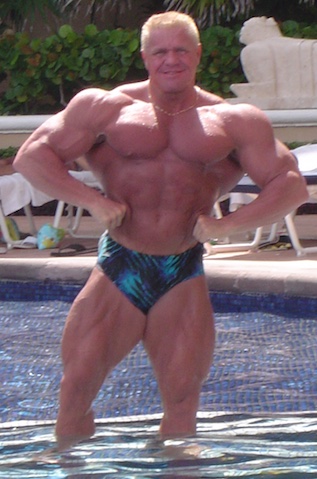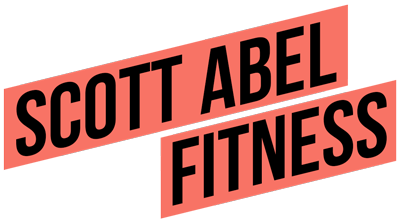Today I want to talk about training for aesthetics vs. training for size.
But first, here is a blast from the past:

Take a look at this picture of me from way back when. Two things are at the heart of this article:
- Advanced muscle development (muscle size, muscle maturity)
- Creating an aesthetically balanced physique
To go further into the past, the first bodybuilding contest I entered, in 1983, I won weighing only 154 lbs. I had to diet down for the contest, and I hadn’t weighed that since my early teens.
Only three years later I competed at just over 200 lbs. and won again. Then a year later in 1987 I won the Great Lakes Classic at 235 lbs. Finally, at my last guest-posing appearance I weighed about 260 lbs., while still being under 10% fat.
Why am I telling you all this? I want to make a point.
What I'm good at, and what I've built a career on, is putting on quality muscle mass and developing a balanced physique. I did it myself. I took my posing-ready “ripped” bodyweight from 154 lbs to 260 lbs during my years of training and dedication to this craft.
Moreover, I helped make just as dramatic a change in thousands of other people as well. When it comes to developing an aesthetically balanced, pleasing physique, I’ve proven myself for decades with both men and women.
I consider what I do a very specific “genre” of expertise in the fitness industry. I consider physique transformation a totally different genre than strength training or powerlifting.
Putting on mass while developing a balanced physique, or sculpting a svelte physique for women, isn’t just about lifting more and more weight. Since I started in this industry “strength” coaches have branded themselves as “experts” in the arena of physique development, but it’s just not true!
If a career-long coach in figure skating decides he/she now wants to coach hockey, or advise hockey players – is the figure skating coach a more reputable expert than a career-long hockey coach? Can you argue they are “the same thing” since both sports take place on ice and involves skating?
Can a soccer coach decide he/she has valuable insight to give football players, since both sports take place on a large field, and both use a ball? An apple and an orange are both fruits; does that make them the same thing?
For far too long this industry has been confused by self-confessed “strength” experts telling trainees how to get big and put on mass. This just has never made any sense to me.
First off, there is more to “putting on mass” than just adding sheer size. I myself wasn’t drawn to the physique side of the fitness industry just “to get huge.”
Back when I took up this game I was impacted by the human “aesthetics” of it all. It wasn’t about mas; it was about “mass with class” – building and creating balanced, sculpted pieces of art worthy of a reflection of Greek sculpture.
Getting “big” is one thing, but acquiring aesthetically pleasing proportions, is where the whole “art of the craft” took me over. I loved the artistic side of it all.
This is why “how much I benched” didn’t interest me. And nor should it interest you, if your goal is aesthetic and balanced physique development. Yes this myth of ‘strength training’ is trending again.
It’s the myth that just won’t die.
Strength experts have a specific paradigm blindness which seems to dictate that whatever the issue or goal, “lifting more” will solve it, because “strength” is the basic foundation at all levels of fitness.
And this is true, in a sense. Strength is a foundation for fitness. But how much you ‘can’ lift is only one specific kind of strength. How much you “should” lift – and where, when, and why in your program—this is where the art and craft of program-design comes in. It is also where the separation of strength-training and physique enhancement should come in as well.
You want to get max-weight strong in “the lifts” then yes, do powerlifting. You want to “get good at Cross-fit,” then do Cross-fit. But let’s not pretend for a minute that these things fall under the umbrella of “physique enhancement training.”
I am a physique transformation specialist, specializing in “balanced and aesthetically pleasing” physique enhancement. I don’t pretend to be a powerlifting coach.
But why are so many “strength” coaches pretending to be experts in how building physiques? This is EXACTLY like the figure skating coach thinking he can be a good hockey coach.
Paradigm blindness has “strength experts” worshipping the basic lifts of bench, squat, deadlift, overhead press and power cleans. There is certainly nothing inherently wrong with these movements per se, but emphasizing only these lifts only – and only for maximum load strength – well, this can produce a very imbalanced-looking physique.
The “strength” experts have a completely different approach than I do. Here are a few differences:
- Strength experts focus on the exercise, and worship specific exercises. Physique enhancement experts focus on the muscles, so that the exercises are only important in the context of how the muscles are used.
- Strength experts say the goal should be to lift more, and that equals results. Physique enhancement experts say the goal should be to lift smarter, to lift better, and use the weights, rather than letting the weights use you.
- The strength expert says how much you lift determines progress. The physique enhancements expert says “how much I should lift” in this particular exercise, for this amount of reps, determines progress.
- Strength experts emphasize, “Train the movement to train the muscles.” Physique enhancement experts say, “Train the muscles, not the movement.”
- Strength experts claim, “Train for strength, and development will come.” Physique enhancement experts say, “Train for development, and a certain kind of strength will come.”
- For strength experts, “The weights work the muscles.” Physique enhancement experts reverse cause and effect, so that for them, “The muscles work the weights.”
Ironically, at the height of my career people would often ask me, “You look fantastic, how much do you bench?” That answer went from “I have no idea” to “I don’t bench.”
I actually found at the highest point of my physique development that the bench press was just too risky for me to do for heavy loads, and it didn’t produce the effects on my physique that I was after.
Back East I have a colleague who fancies himself a powerlifter. The first gym I trained seriously at was a powerlifting gym. He and I started at the same time, way back when. He still competes in powerlifting.
Decades later people ask me, “How much do you bench?” but not many people ask him, because he looks like he’s never been in a gym in his life. His weight hasn’t changed in years. Yet he would easily out-lift me at bench, squat and deadlift for one repetition load-strength.
We have trained for different reasons, and we have achieved different results.
What you need to know and embrace is that strength training and physique enhancement are two different crafts. Just because they use the same tools doesn’t mean they’re the same. An apple isn’t an orange, and a figure skating coach isn’t a hockey coach.
It should be obvious by now that someone who “lifts weights” to enhance their physique isn’t necessarily a “weightlifter.” Their goals are different, and this will affect how they train.
You have to decide what you want to be, what your goals are, and your training has to reflect that.
My coaching clients know this. And if you've read it, you know I talk about this in The Abel Approach (specifically my “Innervation Training” methodology).
Some of you will get it; some of you will not
